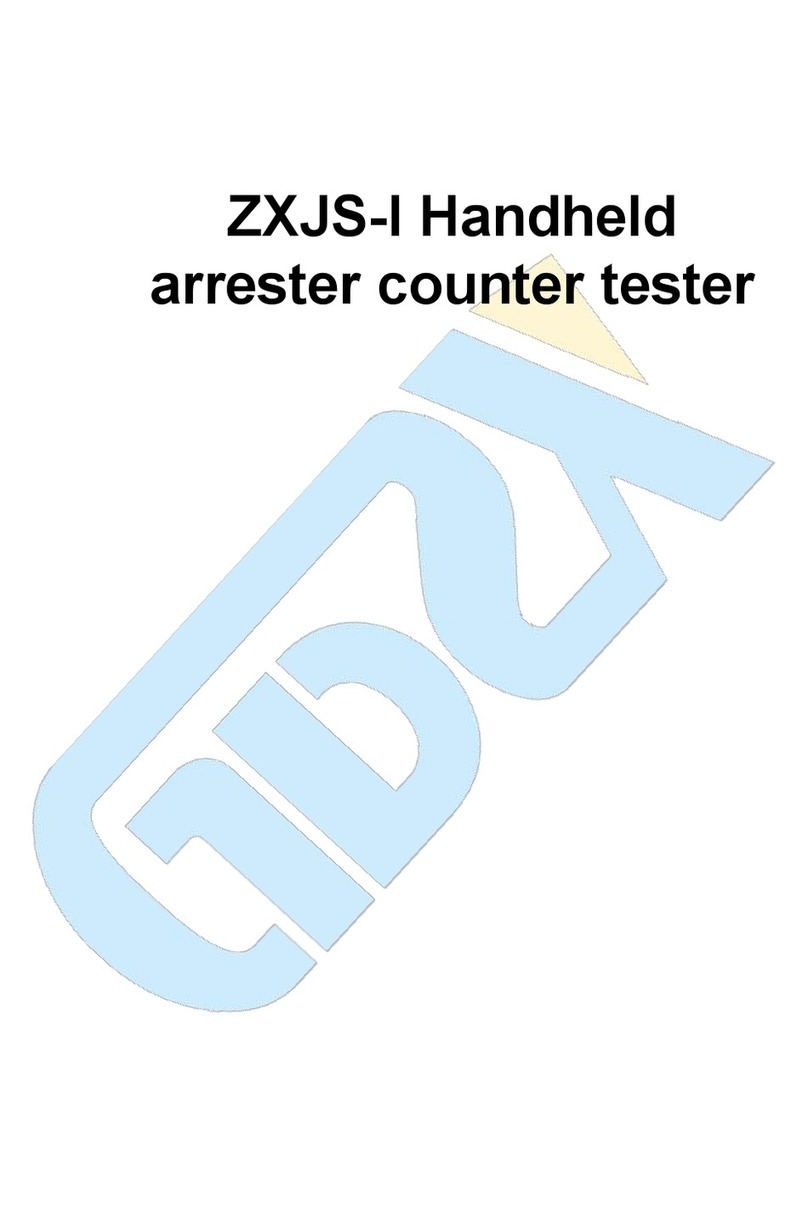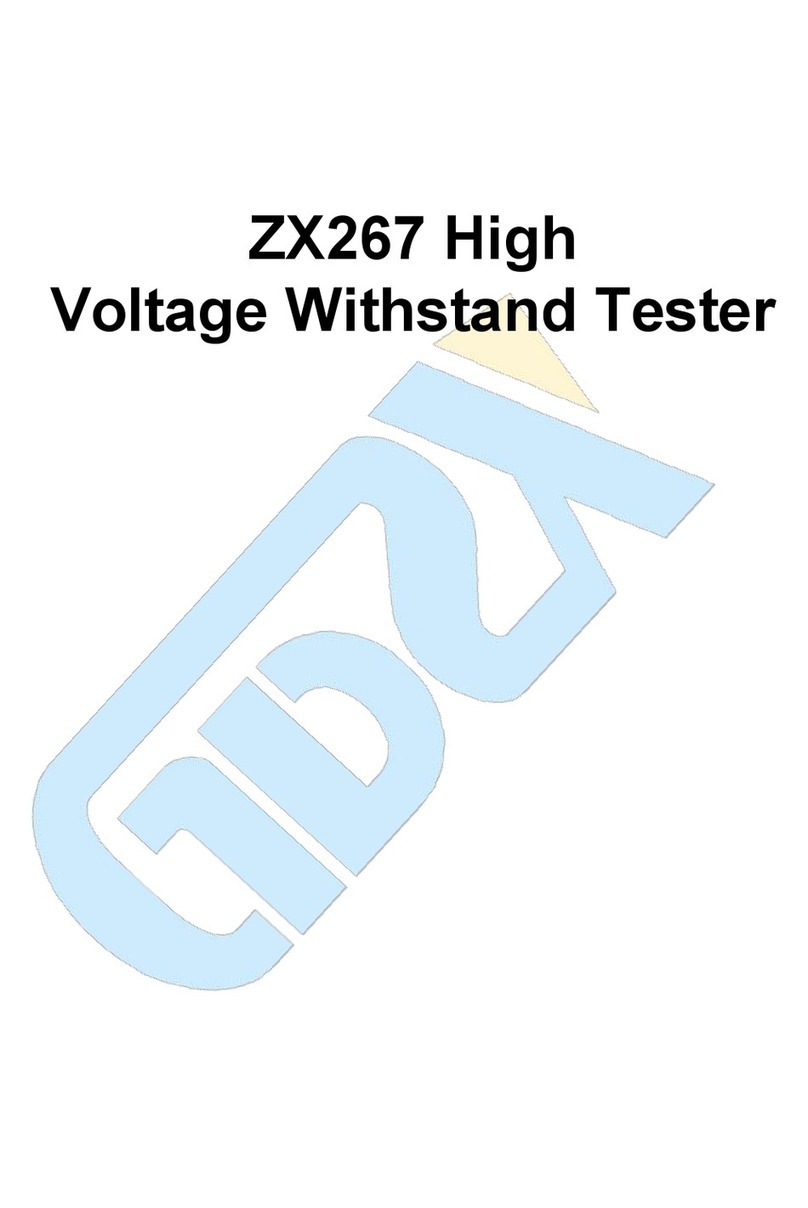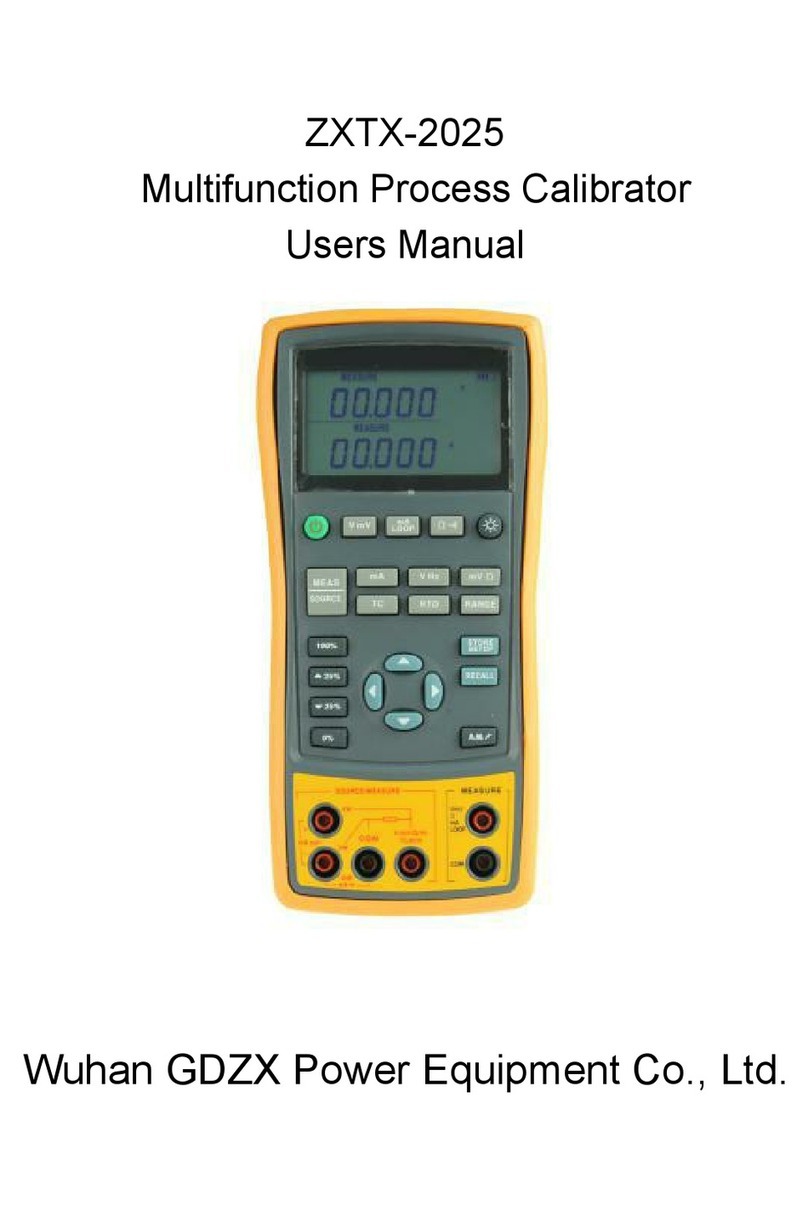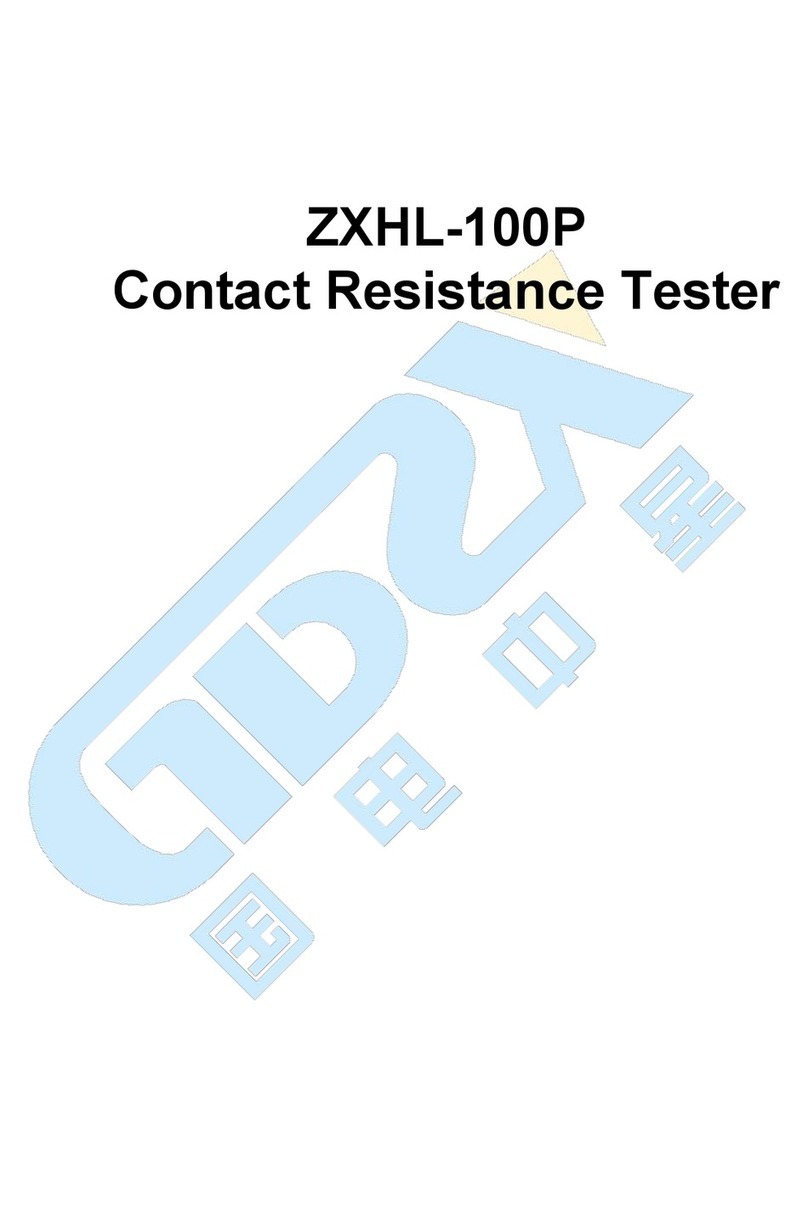GDZX BY2677 User manual

BY2677 Digital
Insulation Resistance Tester

- 1 -
CONTENTS
ⅠSafety information.............................................................................................. - 2 -
ⅡProduct Features................................................................................................- 4 -
ⅢTechnique Indications........................................................................................- 5 -
ⅣMeter Layout....................................................................................................... - 7 -
ⅤKey Functions..................................................................................................... - 9 -
ⅥMeasurement Operation.................................................................................- 12 -
ⅦMeasurement....................................................................................................- 13 -
ⅧReplacing The Battery.................................................................................... - 18 -
ⅨHow to use power adaptor............................................................................. - 19 -

- 2 -
ⅠSafety information
This meter complies with IEC61010 safety measurement requirement.
Warning
Please read and understand this instruction manual carefully before using
the instrument.
whenever necessary, obey the requirements of the manuals and keep the
manuals well for reference
When the instrument is tested, the wrong operation will lead to accidents
and instrument damage.
on this instrument means for safely purpose users should refer to
relevant parts of the manual.
Danger identifies conditions and actions that pose hazards to the user.
Warning alerts the user to avoid electric shock.
Caution identifies conditions or actions that may damage the meter and affect
measurement.
Danger
Do not apply more than 600V.
Do not use the meter around explosive gas, vapor or dust.
When using the test leads, keep your figures away from the lead contacts.
Keep your finger behind the finger guards on the leads.
Do not use the meter with any parts or cover removed.
When carrying out insulation measurement, do not contact the circuit
under test.

- 3 -
Warning
Do not use the meter if it is damaged or metal part is exposed. Look for
cracks or missing part.
Be carefully when working above 33Vrms, 46.7Vac rms or 70Vdc. Such
voltage may cause an electric shock.
discharge all loading of the circuit under test after measuring high voltage
Do not charge battery when it is placed in wet condition.
Place test leads in proper input terminals, make sure all leads are firmly
connected to the input terminals
When opening the battery cover, ensure that the instrument has been
turned off.
Caution
when performing resistance tests, remove all power from the circuit to be
measured and discharge all the power.
when serving the meter, use only the test leads and power adaptor with the
same model or identical electrical specifications.
Do not use the meter if the battery indicator shows a battery empty
condition. Take the battery out from the meter if it is not used for a long
time.
Do no use or store the meter in an environment of high temperature,
humidity, explosive, inflammable and strong magnetic field. The
performance of the Meter may deteriorate after dampended.
Soft cloth and mild detergent should be used to clean the surface of the

- 4 -
Meter when servicing. No abrasive and solvent should be used to prevent
the surface of the meter from corrosion, damage and accident
Dry the meter before storing if it is wet
Risk of electric shock
Equipment protected by double or reinforced insulation
DC measurement
AC measurement
Grounding
ⅡProduct Features
1. Strictly follow IEC61010 safety standard,comply with safety standard of
CAT III 600V and pollution level II.
2. Automatic voltage release function.
3. Backlit for easy work in dark light.
4. bar charts showings the measurement results.
5. High Voltage prompt and red warning light.
6. Auto shutdown when no operation for 15 minutes after measurement,
press ON/OFF for one second to start
7. 18 sets of data storage capacity
8. Time setting function: auto execute the measurement in 15 minutes of the
designated time.
9. COMP measurement (comparative functional measurement)
10.PI measurement (polarization index measurement)

- 5 -
11. Auto measuring resistance ratio can be set in any time duration in PI
measurement.
ⅢTechnique Indications
1. Error limit: ± ([% of reading]+[number of least significant digits]).
2. Ambient temperature: 18~28℃
3. Environmental humidity: 45 ~ 75%RH
4. < insulation resistance test >
Rated voltage
500V
1000V
2500V
5000V
Measuring
range
0.5MΩ~20GΩ
2MΩ~40GΩ
5MΩ~100GΩ
10MΩ~1000GΩ
Open circuit
voltage
DC500V
0%~+20%
DC1000V
0%~+20%
DC2500V
0%~+20%
DC5000V
0%~+20%
Test current
500KΩ load:
1mA~1.2mA
1MΩ load:
1mA~1.2mA
2.5MΩ load:
1mA~1.2mA
5MΩ load:
1mA~1.2mA
Accuracy
0.0MΩ~99.9MΩ:
±(3%+5)
100MΩ~9.99GΩ
:±(5%+5)
10.0GΩ~20.0G
Ω:±(10%+5)
0.0MΩ~99.9MΩ:
±(3%+5)
100MΩ~9.99GΩ
:±(5%+5)
10.0GΩ~40.0G
Ω:±(10%+5)
0.0MΩ~99.9MΩ:
±(3%+5)
100MΩ~9.99GΩ
:±(5%+5)
10.0GΩ~100GΩ
:±(10%+5)
0.0MΩ~99.9MΩ:
±(3%+5)
100MΩ~9.99GΩ
:±(5%+5)
10.0GΩ~99.9G
Ω:±(10%+5)
Above
100GΩ:±(20%+
5)
Humidity:Below
50%
Short circuit
maximum than 2.0mA
Caution
Under any rated voltage, when measured resistance is less than 10MΩ,
continuous measurement should not exceed 10 seconds.
5. <Voltage Measurement>

- 6 -
DC Voltage
AC Voltage
Measuring
range
±30~±600V
30~600V(50/60Hz)
resolution
1V
Accuracy
±(2%+5) 30~100V(50/60Hz)±(2%+8)
6. Display: liquid crystal display, the maximum reading is 9999.
7. Low battery warning: Battery diagram (4 grids) (see Table 1).
8. overrun instruction: "OL"mark appears in the range of insulation
resistance.
9. Automatic ranging function
10.Unit display: function, symbol display.
11. Working conditions: 0 ~ 40℃/ Rh 85% or less.
12.Storage conditions: -20℃to 60℃/ Rh 90% or less.
13.Dimension: 202mm (L) X155mm (W) X94mm (D)
14.Weight: 2kg (containing batteries)
15.Current consumption: about 1.1A (max) (usually at 20mA).
16.Accessories:
1) test line
2) Battery 1.5V (LR14) ×8 pcs
3) Instruction manual
4) Carrying box
5) Special power adapter (input voltage 230V, 50/60Hz, 100mA, output
DC14V, 1.3A).
Caution

- 7 -
Use our company dedicated power adapter, otherwise there will be danger.
ⅣMeter Layout
1. Front
1
LCD
2
Arrow button
3
Emergency stop
4
Data clear the display backlight button
5
▼Arrow button
6
On/off button
7
Compare button
8
Insulation measurement button
9
DC voltage measurement button
10
Timer button
11
AC voltage measurement button
12
Test button
13
USB button
14
Data store button
15
Data recall button
16
Arrow button
17
▲Arrow button
18
LINE:HV input terminal (connected to
two-plug red test lead)
19
High voltage line shielding input
terminal ( connected to two-plug red
test lead)
20
GUARD:grounding protection input
terminal (connected to one-plug black
test lead)
21
EARTH: High resistance
measurement input terminal
( connected to one-plug test lead)
22
Testing leads:
Two-plug red test lead to one alligator
clip
One-plug black test lead to one
alligator clip
One-plug green test lead to one
alligator clip

- 8 -
Figure 1
2. The Meter Side Structure
1
Safety Shutter
2
Power Adaptor Input Terminal
Figure 2
3. Display

- 9 -
Figure 3
ⅤKey Functions
● ON/OFF
Turn on or off the Meter. Press and hold the button for 1 second to turn
the Mete on.Press again to turn off the Meter The Meter defaults at 500v
1
Indicator For DC Voltage
2
Indicator For Data Store Full
3
Indicator For Clearing
4
Indicator For AC Voltage
5
Indicator for timer
6
Step symbol
7
Indicates selected pass/fail
compare value
8
Indicates for negative reading
9
Timer 1 symbol
10
Timer 2 symbol
11
Data store is on
12
Data recall is on
13
Indicator for polarization index
14
Unit symbols
15
The continuity buzzer is on
16
Compare feature pass
17
Analogue bar graph
18
Risk of electric shock
19
Compare feature fail
20
Indicator for power adaptor
21
Battery life indicator

- 10 -
range and under continuous measurement of insulation resistance when
turned on.
● LIGHT
Press to turn on/off the backlight.
● CLEAR
Press to clear the saved data.
● SAVE
Press to store the current measurement value. The Meter can save up to
18 sets.When the stored readings memory is full the Meter shows FULL and
stop stoning Press and hold CLEAR to clear the stored value in order to store
the next measurement value.
● LOAD
Press once to recall the first stored value.
Press again to exit Load feature.
load feature can only be used when there is no high voltage output.
● ▲
When the insulation resistance measurement has no testing voltage
output, press to select previous voltage range .
Under load mode press to recall the previous stored value.
● ▼
When the insulation resistance measurement has no testing voltage
output, press to select next voltage range.
Under load mode: press to recall the next stored value.

- 11 -
●◀
When setting the timer for the measurement of insulation resistance or
polarization index, press to decrement the time, The maximum length of time
is 15 minutes and 30 seconds, the Meter will automatically carry out
measurement.
When com pare function is enabled for insulation resistance measurement
press to decrement a resistance comparing value.After polarization index
measurement press to display polarization index,TIME 2 and TIME 1
insulation resistance values in sequence.
●▶
When setting the timer for the measurement of insulation resistance or
polarization index, press to increment the time. The maximum length of time is
30 minutes and 30 seconds. The Meter will auto carry out measurement.
When compare function is enabled for insulation resistance measurement,
press to increment a resistance comparing value.
After polarization index measurement,press to display polarization index,TIME
2 and TIME 1 insulation resistance values in sequence.
● COMP
Set a pass/fail limit for insulation tests,The default value is 10MΩ.
● TIME
Press to step through continuous,timed and polarization index measurem
-ents in sequence
● TEST

- 12 -
Press to stop or start an insulation resistance test.
● IR
Press to initiate insulation resistance measurement.
● DCV
Press to initiate Dc voltage measurement.
● ACV
Press to initiate AC voltage measurement.
ⅥMeasurement Operation
This section explains how to make measurements.
1. Press and hold ON/OFF to turn on the Meter, press again to turn off the
Meter. The Meter defaults at 500V range and under continuous
measurement of insulation resistance when turned on A Measuring
Voltage.
2. Battery Saver(Sleep Mode)
The Meter enters the Sleep Mode and blanks the display after 15 minutes
inactivity This is done to conserve battery power. The Meter comes out of
Sleep Mode when ON/OFF button is pressed and hold for 1 second.
3. Battery Indication
There is a battery indicator shown on the upper left comer of the display.
Please refer to Table 1 for detailed explanation.
Table 1. Battery Indication
Battery indicator
Battery Voltage

- 13 -
10V or less. It means the battery is empty, don't use the
Meter as it cannot guarantee accuracy.
10V-10.5V It means the battery is.almost empty
replacing battery is necessary. Under this status, the
Meter can still output 500V and 1000V to measure, the
measured accuracy will not be affected.
10.6~11.5V
11.6V or more
When charging battery is applied, the charging battery work mode should be
selected at the startup: Press and hold USB button prior to startup, then press
down ON/OFF, LCD screen will display CHA or GEN, and select to display
CHA by pressing the up/down key, after pressing USB key to confirm, the
Meter successfully enters the charging battery work mode. GEN means the
general alkaline battery work mode.
ⅦMeasurement
1. Voltage Measurement (connection diagram see Figure 4)
1) insert the red test line into the "V" input port. The green test line is inserted
into the "COM" input port.
2) connect the red and green crocodile clip to the tested circuit. When
measuring the DC voltage, if the red test line is negative voltage, then the
"-" negative symbol is displayed on the LCD.

- 14 -
Figure 4
Caution
Do not measure a voltage higher than 600V or 600Vrms. It is possible to
display higher voltage, but it is dangerous and may cause damage to the
instrument.
*when measuring high voltage, pay special attention to avoid electric shock.
*after completing all the measurement operations, we must disconnect the
test line from the tested circuit and remove the test line from the input end
of the instrument.
2. Insulation resistance measurement (connection diagram see Figure 5)

- 15 -
Figure 5
Operating Caution
*before testing, remove all power from the circuit to be measured or
disconnect all the power.Do not measure the insulation in live line.
*Be careful that this instrument has dangerous voltage output, ensure that
the test object is firmed clipped, hand away from the test clip, then press
the TEST key to output high voltage.
Special attention
Do not short circuit two test leads during high voltage output or to measure
insulation resistance after high voltage output. This improper operation is very
easy to generate sparks and cause fire and damage the instrument itself.
Operating Caution

- 16 -
Don’t measure over 10 seconds when
measurement resistance is lower than 2MΩ with use of 500V
measurement resistance is lower than 5MΩ with use of 1000V
measurement resistance is lower than 10MΩ with use of 2500V
measurement resistance is lower than 20MΩ with use of 5000V
When press IR to select insulation resistance measurement but no test
voltage output, press arrow buttons to 500V/1000V/2500V/5000V voltage
range.
1) When performing insulation resistance tester, remove all power from the
circuit to be measured or disconnect all the power.
2) insert the red test line into the "LINE" input port, black test line to "GUARD",
green to "EARTH"
3) Connect the red and black crocodile clip to the tested circuit, negative
voltage outputs from LINE terminal.
4) select one of the following insulation resistance measurement mode:
Continuous measurement
1) Press TIME button to select continuous measurement mode, there is no
timer icon on the LCD screen
2) Press left arrow button and hold right arrow TEST button for 1 second to
carry out and output insulation resistance test voltage, the red Test button
light up, blinks on every 0.5 seconds.
3) Press TEST button turn off the voltage output after test, TEST button lights
off, disappears. The CLD shows the current insulation resistance test

- 17 -
value.
Timed measurement
1) Press TIME button to select the mode, LCD displays "TIME1" and the timer
symbol. Press arrow buttons to set the time ("00:10" and "15:00,within 1
minute, the time increment or decrement by every 5 seconds, afterward,
the time increment or decrement by every 30 seconds), and then press
down the TEST button for 2 seconds to carry out measurements. Time1
and are displayed and blinked on the LCD on every 0.5s.
2) When set time is reached, the test voltage output will be turned off, and the
measurement will be automatically stopped. The LCD displays the
insulation resistance reading.
Polarization index / PI measurement
Press TIME button to select the mode, LCD displays "TIME1" and timer
symbols, press arrow buttons to set time ("00:10" and "15:00, within 1 minute,
the time increment or decrement by every 5 seconds, afterward, the time
increment or decrement by every 30 seconds). After sett TIME1, press TIME
button, "TIME2", "PI" and timer symbols appears on the LCD. Press arrow
buttons to set TIME2 (00:15 ~ 15:30, within 1 minute, the time increment or
decrement by every 5 seconds, afterward, the time increment or decrement by
every 30 seconds). Then press TEST button for 2 seconds, before TIME1
setting time is reached, TIME1 and displayed and blinked on the screen on
every 0.5 seconds. Before TIME2 set time is reached, TIME2 and
displayed and blinked on the screen on every 0.5 seconds. When two set

- 18 -
time are reached, the test voltage output will be turned off . The LCD displays
the polarization index reading. Press arrow buttons to step through the PI,
TIME1 and TIME2 insulation resistance readings.
Calculation tips: polarization index =3 min ~ 10min resistance /30sec ~
1min resistance
absorption than =60sec value /15sec value
PI
4 or more
4~ 2
2.0~ 1.0
1.0 or less
Standard
The best
Good
Warning
bad
Compare function
1) Press COMP button to select compare feature. COMP symbol displays on
the LCD
2) Press arrow buttons to set the compare value
3) You can choose compare from 10MΩ、20MΩ、30MΩ、40MΩ、50MΩ、60MΩ、
70MΩ、80MΩ、90MΩ、100MΩ、200MΩ、300MΩ、400MΩ、500MΩ、600MΩ、
700MΩ、800MΩ、900MΩ、1GΩ、2GΩ、3GΩ、4GΩ、5GΩ、6GΩ、7GΩ、
8GΩ、9GΩ、10GΩ、20GΩ、30GΩ、40GΩ、50GΩ、60GΩ、70GΩ、80GΩ、
90GΩ、100GΩ、200GΩ、300GΩ、400GΩ、500GΩ、600GΩ、700GΩ、
800GΩ、900GΩ
4) Press TEST button for 2 seconds, the NG symbol will display if the
insulation resistance value is smaller than compare value. Otherwise
GOOD symbol will be displayed
ⅧReplacing The Battery

- 19 -
Warning
*Don’t mix to use old and new batteries
*be careful the polarity is correct when installing batteries
*Do not use the meter if the battery indicator show a battery empty
conditions
*Do not carry out measuring during the battery cover is open
Figure 6
Follow figure 6 and proceed as follows:
1) Turn the meter to OFF and remove all connections from the terminals
2) Remove the screw from the battery cover, separate it from the case bottom,
replace the batteries
3) Rejoin the case bottom and battery cover and reinstall the screw
ⅨHow to use power adaptor
Open the side safety shutter, then you will see there is a power adaptor input
terminal,make sure the meter is power off and insert the power adaptor to the
Table of contents
Other GDZX Test Equipment manuals
Popular Test Equipment manuals by other brands

Redtech
Redtech TRAILERteck T05 user manual

Venmar
Venmar AVS Constructo 1.0 HRV user guide

Test Instrument Solutions
Test Instrument Solutions SafetyPAT operating manual

Hanna Instruments
Hanna Instruments HI 38078 instruction manual

Kistler
Kistler 5495C Series instruction manual

Waygate Technologies
Waygate Technologies DM5E Basic quick start guide

StoneL
StoneL DeviceNet CK464002A manual

Seica
Seica RAPID 220 Site preparation guide

Kingfisher
Kingfisher KI7400 Series Training manual

Kurth Electronic
Kurth Electronic CCTS-03 operating manual

SMART
SMART KANAAD SBT XTREME 3G Series user manual

Agilent Technologies
Agilent Technologies BERT Serial Getting started















